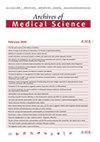Causal association of plasminogen activators and their inhibitors with Alzheimer's disease: a Mendelian randomization study
IF 3
4区 医学
Q1 MEDICINE, GENERAL & INTERNAL
引用次数: 0
Abstract
Alzheimer's disease (AD) is the most common cause of dementia, and contributes to a huge burden of disease worldwide. Observational studies have found that tissue plasminogen activator (t-PA) inhibits the development of AD, but little is known about urokinase plasminogen activator (u-PA) and plasminogen activator inhibitor-1 (PAI-1). At present, the causal relationship is not clear. Therefore, this study intends to explore the relationship between plasminogen activators and their inhibitors with Alzheimer's disease through Mendelian randomization method, so as to provide reference for the prevention and control of Alzheimer's disease.To investigate causal pathways, we conducted a two-sample Mendelian randomization study using pooled statistics from genome-wide association studies. IVW, MR-Egger, Weighted-median, MR-PRESSO and MR-RAPS methods were used to evaluate the robustness of the results.In the outcome of AD (more controls excluded), the IVW effect of PAI-1 OR (95%CI) was found as follows: 1.543 (1.010-2.356), whose interval does not include 1 and P=0.0448, which suggested that PAI-1 was positively correlated with the risk of AD (more controls excluded). The IVW model, Weighted median, MR-PRESSO and MR-RAPs all showed similar results (all ORs >1), and the two outcomes were consistent.Our results showed that gene-predicted PAI-1 in Mendelian stochastic analysis was associated with an increased risk of AD.纤溶酶原激活剂及其抑制剂与阿尔茨海默病的因果关系:孟德尔随机研究
阿尔茨海默病(AD)是导致痴呆症的最常见病因,给全世界造成了巨大的疾病负担。观察性研究发现,组织纤溶酶原激活剂(t-PA)可抑制阿尔茨海默病的发展,但人们对尿激酶纤溶酶原激活剂(u-PA)和纤溶酶原激活剂抑制剂-1(PAI-1)知之甚少。目前,两者之间的因果关系尚不明确。因此,本研究拟通过孟德尔随机方法探讨纤溶酶原激活剂及其抑制剂与阿尔茨海默病的关系,从而为阿尔茨海默病的防治提供参考。为了探究因果关系途径,我们利用全基因组关联研究的集合统计数据进行了双样本孟德尔随机研究。我们使用了IVW、MR-Egger、加权中值、MR-PRESSO和MR-RAPS方法来评估结果的稳健性。在AD结果中(排除了更多对照),PAI-1 OR的IVW效应(95%CI)如下:1.543(1.010-2.356),其区间不包括1,P=0.0448,这表明PAI-1与AD风险呈正相关(排除更多对照)。我们的结果表明,孟德尔随机分析中基因预测的 PAI-1 与 AD 风险增加有关。
本文章由计算机程序翻译,如有差异,请以英文原文为准。
求助全文
约1分钟内获得全文
求助全文
来源期刊

Archives of Medical Science
医学-医学:内科
CiteScore
4.90
自引率
7.90%
发文量
139
审稿时长
1.7 months
期刊介绍:
Archives of Medical Science (AMS) publishes high quality original articles and reviews of recognized scientists that deal with all scientific medicine. AMS opens the possibilities for young, capable scientists. The journal would like to give them a chance to have a publication following matter-of-fact, professional review by outstanding, famous medical scientists. Thanks to that they will have an opportunity to present their study results and/or receive useful advice about the mistakes they have made so far.
The second equally important aim is a presentation of review manuscripts of recognized scientists about the educational capacity, in order that young scientists, often at the beginning of their scientific carrier, could constantly deepen their medical knowledge and be up-to-date with current guidelines and trends in world-wide medicine. The fact that our educational articles are written by world-famous scientists determines their innovation and the highest quality.
 求助内容:
求助内容: 应助结果提醒方式:
应助结果提醒方式:


